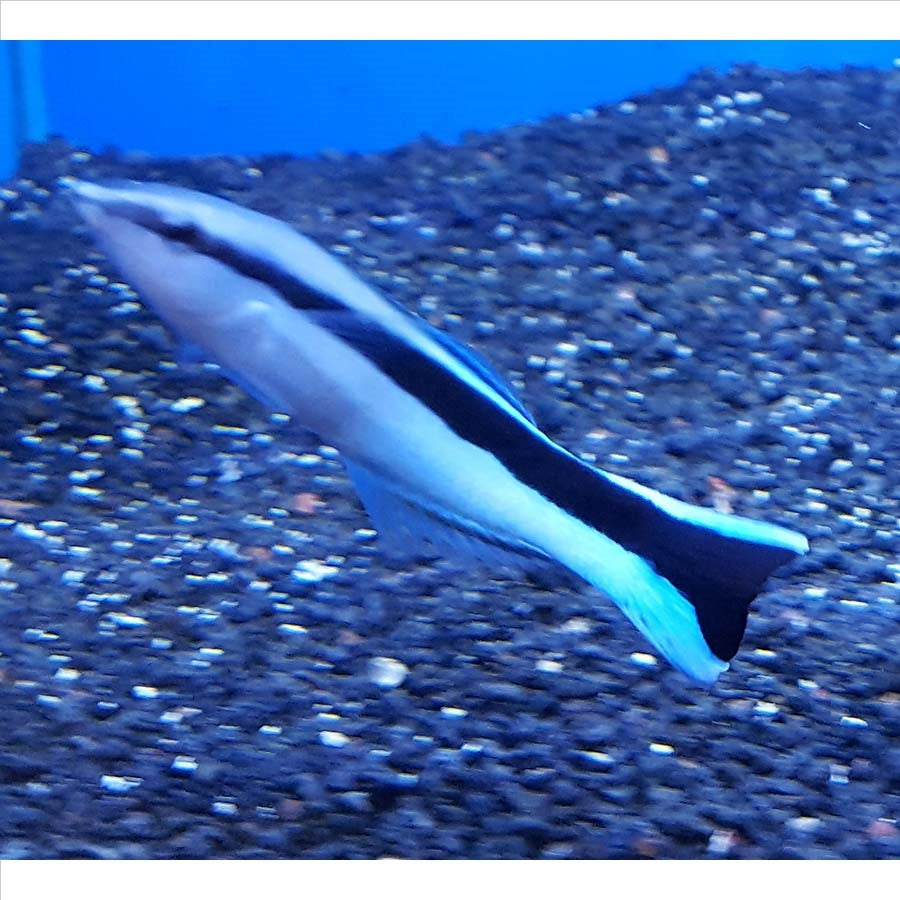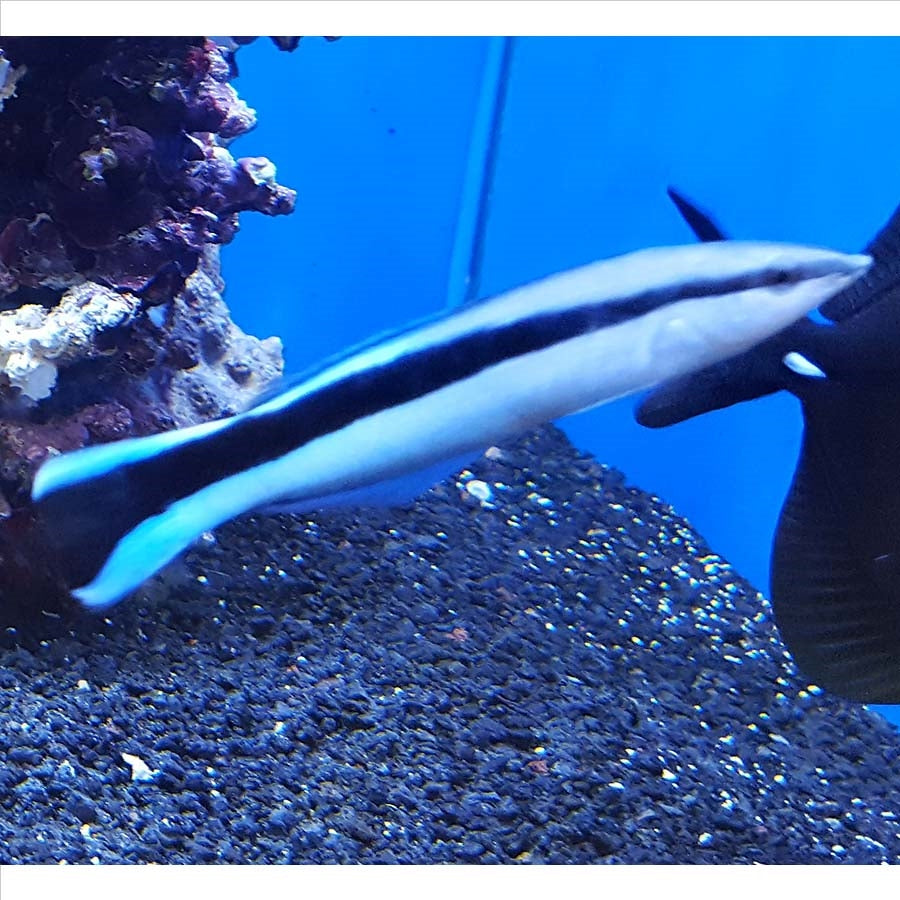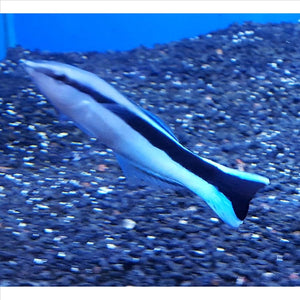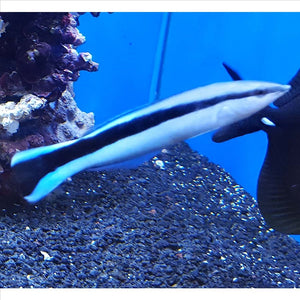Description:
The term "Cleaner Wrasse" most commonly refers to the Bluestreak Cleaner Wrasse (Labroides dimidiatus). These fish are iconic for their fascinating symbiotic relationship with other reef fish, where they set up "cleaning stations" and remove parasites, dead skin, and mucus from their "client" fish.
However, despite their interesting behavior and perceived utility, Cleaner Wrasses are notoriously difficult to keep long-term in home aquariums, making them an Advanced/Expert level fish. Their specialized diet is the primary reason for their high mortality rate in captivity.
Here's a comprehensive care guide for the Bluestreak Cleaner Wrasse (Labroides dimidiatus):
Appearance:
-
Body: Elongated, slender body with a pointed snout.
-
Coloration: Typically a bright blue stripe running along the back, widening towards the tail. The lower body is usually white or yellowish, and a prominent black stripe runs from the snout, through the eye, along the middle of the body, extending into the tail fin.
-
Unique Mouth: They have small, tweezer-like teeth adapted for picking parasites.
Adult Size:
- Bluestreak Cleaner Wrasses typically reach an adult size of 4 to 5.5 inches (10-14 cm).
Natural Habitat and Distribution:
- Found widely throughout the Indo-Pacific region, including the Red Sea, East Africa, and extending to French Polynesia, north to southern Japan, and south to Australia (including the Great Barrier Reef, relevant for Caboolture).
- Inhabit coral reefs, setting up "cleaning stations" where other fish, both large and small, visit to be cleaned. They are highly active during the day.
Aquarium Care (Advanced/Expert Level - Very Difficult to Keep Long-Term):
-
Minimum Tank Size: A minimum of 50-75 gallons (190-284 liters) is recommended for a single Cleaner Wrasse. While they are small, they are extremely active and need ample swimming space to constantly patrol for clients.
-
Water Parameters: Maintaining pristine and highly stable water quality is essential.
-
Temperature: 74-79°F (23-26°C)
-
Salinity: 1.020-1.025 specific gravity
-
pH: 8.1-8.4
-
Alkalinity (dKH): 8-12 dKH
- Ammonia and nitrites must be 0 ppm. Nitrates should be kept as low as possible, ideally below 10-20 ppm.
-
Filtration: Robust filtration is essential to handle their constant activity and prevent water quality issues.
-
Water Flow: Moderate to strong water flow is suitable.
-
Diet: THIS IS THE PRIMARY CHALLENGE.
-
Obligate Cleaner: In the wild, their diet consists almost exclusively of ectoparasites, dead skin, and mucus removed from other fish. They are constantly feeding throughout the day.
-
Starvation in Captivity: Most home aquariums simply do not have enough "client" fish or enough parasites to sustain a Cleaner Wrasse. Even if they appear to accept prepared foods, these foods often do not provide the exact nutritional profile they need, leading to a slow decline from malnutrition, even if they eat. Many do not survive beyond a few weeks or months.
-
Attempted Foods (often with limited success): Some hobbyists attempt to offer small meaty frozen foods like vitamin-enriched mysis shrimp, brine shrimp, cyclop-eeze, and finely chopped clam or squid. There are reports of them eating high-quality marine flakes or even occasionally beef heart, but this is rare.
-
Frequent Feeding: If you try to keep one, you must feed small quantities of food multiple times per day (e.g., 5+ times a day) to try and replicate their natural constant feeding.
-
Large, Diverse Fish Population: The best chance of success is in a very large (hundreds of gallons), well-established aquarium with a high density of diverse fish species that would naturally provide a constant supply of parasites and other cleaning opportunities.
-
Temperament:
-
Peaceful: Generally peaceful towards most other tank mates. They are quite bold and will approach almost any fish, even aggressive ones, to offer cleaning services.
-
Territorial Towards Conspecifics: Can be territorial towards other Cleaner Wrasses (especially males) in smaller tanks. Best kept singly, unless in a very large system where a mated pair or small group (one male, multiple females) can be attempted.
-
Pestering: In tanks with too few fish, they may pester tank mates excessively, causing stress to the other fish.
-
Reef Compatibility: Generally considered reef safe. They will not harm corals or most invertebrates. Some anecdotal reports suggest they might occasionally nip at the mantle of Tridacnid clams if very hungry, but this is uncommon.
-
Tank Setup:
- Provide plenty of live rock with caves and crevices for hiding and establishing "cleaning stations."
- Ensure ample open swimming space.
- A tight-fitting lid is absolutely essential as they are known jumpers, especially when startled or new to the tank.
-
Disease Susceptibility: While they clean parasites, they are not immune to them. Stress from improper diet and unsuitable conditions can make them susceptible to common marine diseases.
-
Acclimation: Slow and careful drip acclimation is crucial.
![Eco Tech Advanced Reptile Thermostat - Dimming - Dual Electronic Thermostat.]()






